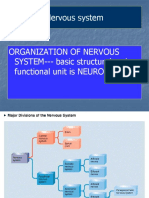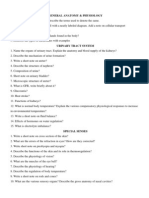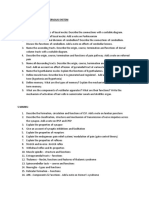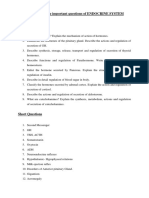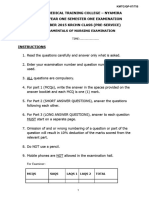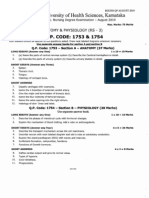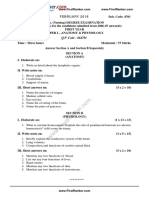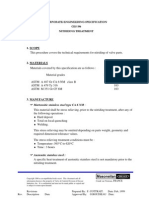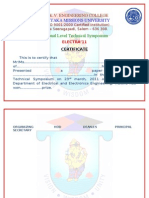ANATOMY AND PHYSIOLOGY Question Bank
ANATOMY AND PHYSIOLOGY Question Bank
Uploaded by
MATHANKUMAR.SCopyright:
Available Formats
ANATOMY AND PHYSIOLOGY Question Bank
ANATOMY AND PHYSIOLOGY Question Bank
Uploaded by
MATHANKUMAR.SOriginal Description:
Copyright
Available Formats
Share this document
Did you find this document useful?
Is this content inappropriate?
Copyright:
Available Formats
ANATOMY AND PHYSIOLOGY Question Bank
ANATOMY AND PHYSIOLOGY Question Bank
Uploaded by
MATHANKUMAR.SCopyright:
Available Formats
DEPARTMENT OF BIOMEDICAL ENGINEERING QUESTION BANK Course: M.
E Biomedical Engineering Semester: I
ANATOMY AND PHYSIOLOGY
UNIT - I PART A 1. Write short notes on embryonic period. 2. Classify the different types of bones. 3. Mention the types of bone marrow and its function. 4. What is myology? 5. What is osteology? 6. Define anatomical position. 7. Mention the major organ system and their role in human body. 8. What are cell organelles? 9. Write short note on Endoplasmic reticulum. 10. What are the different types of blood circulation? 11. What is half cell potential? 12. How Sodium-Potassium Pump is working? 13. Define action potential. 14. Define resting membrane potential. 15. What is chloride shift? 16. List out the function of lysosomes. 17. What is the function of Mitochondria? 18. Write short notes on DNA 19. Define eosinophilia. 20. What is phagocytosis? 21. What is bioelectric potential? 22. What are the significant of bioelectric potential? 23. What is a bio potential electrode? 24. Name the types of bio potential electrodes. 25. Draw the measurement of biopotential equivalent circuit. PART - B 1. Define cell and write an essay on eukaryotic cell structure. 2. Draw and explain with neat Diagram of the formation of Embryo and fetus. 3. Describe long bone in detail and add a note on blood supply and applied anatomy. 4. Explain in detail about the Muscles of the abdominal wall. 5. Explain the principle with neat diagram of Action Potential. 6. Write in detail about Muscles of the Face and Neck. 7. Explain in detail about the circulatory system in the human body. 8. Explain in detail about the cardio vascular system. 9. Explain in detail about the central nerve system. 10. Explain in detail about bio electric potential.
UNIT - II PART A 1. Name the parts of the respiratory system. 2. Distinguish right and left lung. 3. Mention the lobes of the lungs. 4. Write short note on function of nasal cavity. 5. What are the different parts of pharynx? 6. List out the name of the cartilage which covers the larynx 7. What is gaseous exchange? Where it takes place? 8. Differentiate right and left bronchi. 9. Define bronchial tree. 10. What is conducting system? 11. Define cardiac cycle. 12. What is SA node? Where it is located? 13. Name the respiratory center of brain. 14. Mention the muscles involved in inspiration. 15. Define anatomical dead space. 16. Define alveolar ventilation rate. 17. Name the covering of the Heart and it components. 18. Where is the Heart located? 19. Differentiate arteries from veins. 20. Define dysponea. 21. What is the main function of heart? 22. Define function of lungs. 23. What is capillary circulation? 24. What is meant by inhale and exhale? 25. How the lung carrier the O2 and CO2? PART B 1. 2. 3. 4. 5. 6. 7. 8. 9. 10. Describe the structure of upper respiratory system in details. Explain the anatomy of pharynx, larynx and trachea and mention their role. Write a short essay on lung and mention the difference between right and left lungs. Explain in detail about the mechanism and regulation of breathing. Describe the transport of gases by blood. Give an account on electrical and mechanical events of heart. Describe the anatomy of heart in details. Describe the veins drainage of thorax, abdomen and lower extremity. What is circulatory system? Explain in brief about different types of circulation. Give a short note on the following I. Valves and blood vessels of Heart II. Conducting system of heart
UNIT - III PART -A 1. 2. 3. 4. 5. 6. 7. 8. 9. 10. 11. 12. 13. 14. 15. 16. 17. 18. 19. 20. 21. 22. 23. 24. 25. PART -B 1. 2. 3. 4. 5. 6. 7. 8. 9. Define Neuron. Classify the nervous system. What is a nerve fibre? How are they classified? What are nuclei and ganglia? Name the cells responsible for myelination of neurons. What is meant by cerebro spinal fluid? Define synapse. What is the functional classification of neurons? What is the neuroglia? Name the different types of neuroglia. Name the lobes of cerebral hemisphere. What is brain stem? Mention the coverings of the spinal cord. Write note on functions of nervous system. What is fovea centralis? Name the muscle which moves the eye ball. What is meant by sensory system? Name the ear ossicles. Mention the functions of semicircular canals. Name the nerve which is related to hearing. Mention different layer of eye ball. What is meant by physiology emotion? Name the papillae of tongue. What are functions of the tympanic membrane? What is function nerves system? What is meant by hearing and smelling?
Describe the structure of the spinal cord. Describe the brain in details add a note on blood supply. Give an account on Peripheral Nervous System. Explain in detail about the functional and morphological classification of Neurons. Write a short essay on reflex arc and reflexes. Write in detail about the structure of ear with neat diagram. Explain the physiology of hearing and equilibrium. Briefly describe the structure of eye ball and add a short note on the physiology of vision. Give a short note on the following I. Accessory structure of eye II. Taste buds and sense of taste 10. Explain the cerebro spinal fluid and sensory end organs.
UNIT - IV PART - A What are parts of small intestine? What are Rugae? Write about the blood supply in stomach. List the content of gastric juice. Mention the functions of liver. What are the differences between small and large intestine? What is the function of esophagus? Write short note on tongue. Mention the functions of stomach. Name the different types of teeth. What are the compositions of saliva? What is esophageal hiatus? Define villi and microvilli. Name the parts of colon. Write short note on lobes of liver. Define liver sinusoids. List out the parts of large intestine. What is appendix? Name the bones that form the roof of mouth. Define frenulum. What is meant by alimentary canal? What is mechanism of alimentary canal? What are the secretions of digestive fluids? Structure of alimentary canal? Define gall bladder? PART - B 1. Describe in detail about stomach including the structure, blood and nerve supply. 2. Briefly describe about the anatomy and role of tongue and teeth. 3. Mention the parts of small intestine and add note on the anatomy and role of each part. 4. Explain in detail about the digestive process. 5. Write a short essay on membrane, tunics and innervations of GI tract. 6. Elaborate on large intestine with neat diagram. 7. Explain the location, anatomy and role of liver. 8. Explain in detail about pancreases. 9. Explain in detail about the alimentary canal. 10. Explain in detail about the gall bladder. 1. 2. 3. 4. 5. 6. 7. 8. 9. 10. 11. 12. 13. 14. 15. 16. 17. 18. 19. 20. 21. 22. 23. 24. 25.
UNIT - V PART - A 1. Which is known as master of endocrine glands, why it is called so? 2. Mention the hormones secreted by adrenal medulla. 3. Define Nephron. 4. What are the parts of urinary system? 5. What is a renal pyramid? Where does the renal papilla open? 6. What are the two types of nephrons and where they are located? 7. Mention the functions of urinary system. 8. What are the parts of male urethra? 9. Mention the hormones secreted by thyroid glands. 10. Name the cells responsible for secreting insulin. Name the gland in which they are located. 11. Mention the different zones of adrenal cortex. Mention the hormones secreted by each zone. 12. What are the hormones secreted by female gonad? 13. What are the parts of pituitary gland? 14. Mention the covering of the testis. 15. What is testosterone? Where it is produced? What are its functions? 16. Where the kidneys are located? 17. What is GFR? 18. How total plasma volume filters into the renal tubules 19. List out the physical character of urine. 20. Define Micturition. 21. Draw the structure of kidney. 22. What is meant by thyroid? 23. What is meant by physiology of urine formation? 24. What is the pituitary gland? 25. Define parathyroid. PART - B 1. Define endocrine gland and mention the endocrine glands of human body. Describe in detail about pituitary glands. 2. Elaborate the structure and function of adrenal gland. 3. Explain in detail about the anatomy of kidney. 4. Give an account on urinary bladder and urethra. 5. Describe the mechanism of urine formation. 6. Explain the role of large intestine in defecation. 7. List out and explain the diseases of kidney. 8. Explain in detail about Thyroid and parathyroid gland. 9. Explain in detail about Gonads, pineal and thymus gland. 10. Explain in detail about pancreas, ovary and tests.
You might also like
- Anatomy and Physiology Lecture Notes 1 &2Document3 pagesAnatomy and Physiology Lecture Notes 1 &2Ivy100% (2)
- MCQ Introduction of Anatomy 2013-2014 by Dr. Noura PDFDocument3 pagesMCQ Introduction of Anatomy 2013-2014 by Dr. Noura PDFFaddy Oraha77% (26)
- Introduction To Nursing PharmacologyDocument140 pagesIntroduction To Nursing PharmacologyCharmie Ganda75% (16)
- Acute Coronary Syndrome NCP 02Document6 pagesAcute Coronary Syndrome NCP 02AgronaSlaughterNo ratings yet
- CH 4 Tissue Practice TestDocument15 pagesCH 4 Tissue Practice TestMelody B. MiguelNo ratings yet
- Selective Anatomy Vol 2 Ebook (PDFDrive)Document613 pagesSelective Anatomy Vol 2 Ebook (PDFDrive)Adithya Chordia100% (1)
- Anatomy and Physiology Final Exam MsuDocument10 pagesAnatomy and Physiology Final Exam MsuAlibasher Macalnas100% (1)
- Examination Questions and Answers in Basic Anatomy and Physiology. 2000 Multiple Choice Questions - Martin CaonDocument508 pagesExamination Questions and Answers in Basic Anatomy and Physiology. 2000 Multiple Choice Questions - Martin CaonMiguel Angel Mendoza Zabalaga67% (6)
- 1st Year Basic BSC Nursing Anatomy Word Notes in DetailsDocument2 pages1st Year Basic BSC Nursing Anatomy Word Notes in DetailsShreyas Walvekar100% (1)
- The Nervous System - NursingDocument59 pagesThe Nervous System - NursingDR Archana Agarwal100% (2)
- The Respiratory System - Test QuestionsDocument4 pagesThe Respiratory System - Test Questionsflorin100% (3)
- Physiology Question Bank FinalDocument16 pagesPhysiology Question Bank Finalatefmabood100% (2)
- MCQ On Anatomy & PhysiologyDocument5 pagesMCQ On Anatomy & PhysiologySivasankaran GovindasamyNo ratings yet
- 1-Blood Composition and FunctionDocument43 pages1-Blood Composition and FunctionKaleem Mohammad100% (3)
- The Urinary System - Test QuestionsDocument4 pagesThe Urinary System - Test QuestionsflorinNo ratings yet
- Anatomy & Physiology QuestionsDocument10 pagesAnatomy & Physiology Questionskrishna chandrakani100% (2)
- 1753 Anatomy Question BankDocument9 pages1753 Anatomy Question BankPrasannaNo ratings yet
- CNS - Important QuestionsDocument2 pagesCNS - Important Questionsavantika rajeev100% (4)
- ANATOMY SHORT ANSWER QUESTIONS BANK September 2009Document37 pagesANATOMY SHORT ANSWER QUESTIONS BANK September 2009Sodeinde SimeonNo ratings yet
- Question Bank For Human Anatomy and Physiology I Year B Pharmacy SyllabusDocument7 pagesQuestion Bank For Human Anatomy and Physiology I Year B Pharmacy Syllabusthomasarun200983% (12)
- Anatomy Question BankDocument26 pagesAnatomy Question BankArul ValanNo ratings yet
- Endocrine Imp QuestionsDocument2 pagesEndocrine Imp Questionsdr_mksinhaNo ratings yet
- Year 1 Sem 1 - Fundamentals of NursingDocument6 pagesYear 1 Sem 1 - Fundamentals of Nursingfelixkirui830% (1)
- KUHS B.SC Nursing 1st Year Physiology Important Question BankDocument10 pagesKUHS B.SC Nursing 1st Year Physiology Important Question BankShabir Khan50% (2)
- End of Semester 1 Anatomy & PhysiologyDocument5 pagesEnd of Semester 1 Anatomy & Physiologynancygakii316100% (1)
- Unit Wise Question BankDocument3 pagesUnit Wise Question BankIshika RajputNo ratings yet
- Nursing Foundation Important QuestionsDocument10 pagesNursing Foundation Important Questionsল ক্ষ ন100% (1)
- First Year B.Sc. Nursing Question Paper2010Document14 pagesFirst Year B.Sc. Nursing Question Paper2010Biju Antony90% (10)
- Important SEQs of General Histology For 1st Year Mbbs Students by Dr. RoomiDocument2 pagesImportant SEQs of General Histology For 1st Year Mbbs Students by Dr. RoomiMudassar Roomi91% (11)
- Muscular System Quiz 01 - Attempt ReviewDocument13 pagesMuscular System Quiz 01 - Attempt ReviewPsalm Jirehmae SantosNo ratings yet
- Foundation of Nursing OBJ QUESTIONSDocument12 pagesFoundation of Nursing OBJ QUESTIONSElla AdogunNo ratings yet
- First Year B.Sc. Nursing Question Paper 2009Document15 pagesFirst Year B.Sc. Nursing Question Paper 2009Biju Antony100% (7)
- B.SC Nursing - 2018 - Question Papers - First Year - Anatomy and Physiology FR 1 PDFDocument1 pageB.SC Nursing - 2018 - Question Papers - First Year - Anatomy and Physiology FR 1 PDFabriham gebera100% (1)
- Urinary SystemDocument95 pagesUrinary SystemCloud D. Luffy100% (1)
- Assignment FONDocument5 pagesAssignment FONMehran AhmadNo ratings yet
- Anatomy & Physiology Unit 1Document29 pagesAnatomy & Physiology Unit 1Priyanjali Saini100% (1)
- Sindh Nurses Examination Board KarachiDocument9 pagesSindh Nurses Examination Board KarachiBurhan uddin100% (3)
- Question Paper CBRDocument1 pageQuestion Paper CBR4Kmedia status100% (1)
- Tissue Exam QnsDocument4 pagesTissue Exam Qnsvarsha thakur100% (1)
- B.SC Nursing 2018 Question Papers First Year English FR 2Document2 pagesB.SC Nursing 2018 Question Papers First Year English FR 2Himanshu50% (2)
- MCQ in Basic Anatomy and Physiology PDFDocument605 pagesMCQ in Basic Anatomy and Physiology PDFFebriyanti100% (12)
- New GNM Question PaperDocument2 pagesNew GNM Question Papermelby2604100% (1)
- First AId Notes - UpdatedDocument54 pagesFirst AId Notes - Updatedewawire100% (1)
- Factors Affecting Body Alignment & Activity 1. 2. 3.Document5 pagesFactors Affecting Body Alignment & Activity 1. 2. 3.LE-JEAN BRENA100% (2)
- Digestive System Anatomy and Physiology - NurseslabsDocument33 pagesDigestive System Anatomy and Physiology - NurseslabsMari FeNo ratings yet
- The Nursing ProcessDocument83 pagesThe Nursing ProcessShreya SinhaNo ratings yet
- Mbbs Part 1 Uhs SyllabusDocument14 pagesMbbs Part 1 Uhs SyllabusMudassar Roomi100% (1)
- Anatomy and Physiology Exhibition 2013Document2 pagesAnatomy and Physiology Exhibition 2013慧莉No ratings yet
- Behavioral Sciences - Topical Past PapersDocument10 pagesBehavioral Sciences - Topical Past PapersRohama Qubra 279No ratings yet
- 1 Year B.SC Nursing Psychology (QP - Code-1758) Question Bank Unit - I: IntroductionDocument9 pages1 Year B.SC Nursing Psychology (QP - Code-1758) Question Bank Unit - I: IntroductionShri Nidhi100% (1)
- Knee & Leg MCQ - ProProfs QuizDocument8 pagesKnee & Leg MCQ - ProProfs QuizBassamSheryanNo ratings yet
- Anatomy of The Digestive SystemDocument46 pagesAnatomy of The Digestive Systemprincess joy sustiguerNo ratings yet
- Skeletal System ExamDocument9 pagesSkeletal System ExamBijay Kumar Mahato100% (1)
- Unit1 Health Assessment FirstDocument44 pagesUnit1 Health Assessment Firstzonishaadan250% (2)
- Paper: Nursing Ethics Semester # 4ThDocument9 pagesPaper: Nursing Ethics Semester # 4ThAamir100% (2)
- The Integumentary SystemDocument10 pagesThe Integumentary SystemAlliyah Guerrero100% (1)
- 1754 Physiology Question BankDocument6 pages1754 Physiology Question BankLYRIYANo ratings yet
- Course ObjectivesDocument4 pagesCourse ObjectivesAdam NicholsNo ratings yet
- PAST Q PHYSIOLOGY-Merged-1 PDFDocument15 pagesPAST Q PHYSIOLOGY-Merged-1 PDFvbbvvh82No ratings yet
- B.SC in Medical Technology (Laboratory) Question Sub: Anatomy & Histology, MTL-102Document2 pagesB.SC in Medical Technology (Laboratory) Question Sub: Anatomy & Histology, MTL-102Shamim AhmedNo ratings yet
- WS - Life Processes-ImpDocument8 pagesWS - Life Processes-ImpAISHA AMAL ANDIKATTILASSLAM ANDIKATTILNo ratings yet
- Sharira KriyaDocument11 pagesSharira KriyaKi Ñg Sharul SharmaNo ratings yet
- Adaptive Control Question Bank Without Answer KeyDocument5 pagesAdaptive Control Question Bank Without Answer KeyMATHANKUMAR.S100% (1)
- Biomedical Engineering Project: A Biosensor Based On Silver Enhanced Self Assembled Rfid Antenna.Document4 pagesBiomedical Engineering Project: A Biosensor Based On Silver Enhanced Self Assembled Rfid Antenna.MATHANKUMAR.SNo ratings yet
- Biomedical Engineering Alumi Details (Vmkvec)Document3 pagesBiomedical Engineering Alumi Details (Vmkvec)MATHANKUMAR.SNo ratings yet
- Matlab Basic Questions Without AnswersDocument1 pageMatlab Basic Questions Without AnswersMATHANKUMAR.SNo ratings yet
- Biomaterials PPT - IITDocument12 pagesBiomaterials PPT - IITMATHANKUMAR.SNo ratings yet
- Telemedicine-Introduction: Telemedicine Is The Remote Communication of Information To Facilitate Clinical CareDocument8 pagesTelemedicine-Introduction: Telemedicine Is The Remote Communication of Information To Facilitate Clinical Caresuhail_ahmed018No ratings yet
- Electrical Engineering QUESTION BANKDocument7 pagesElectrical Engineering QUESTION BANKMATHANKUMAR.S100% (1)
- Top Three Rankers in EIEDocument1 pageTop Three Rankers in EIEMATHANKUMAR.SNo ratings yet
- Module 1 Lecture 1 What Is InformaticsDocument28 pagesModule 1 Lecture 1 What Is InformaticsMATHANKUMAR.SNo ratings yet
- Nitriding Ces-196 ADocument3 pagesNitriding Ces-196 AMATHANKUMAR.SNo ratings yet
- Top Three Rankers in BMEDocument1 pageTop Three Rankers in BMEMATHANKUMAR.SNo ratings yet
- Breast Cancer (Research Paper)Document12 pagesBreast Cancer (Research Paper)Katrina Arnaiz100% (4)
- Sponsor Project List EEEDocument3 pagesSponsor Project List EEEMATHANKUMAR.SNo ratings yet
- Call Center Faculty DetailsDocument6 pagesCall Center Faculty DetailsMATHANKUMAR.SNo ratings yet
- V. M. K. V. Engineering College, Salem: Vinayaka Missions UniversityDocument1 pageV. M. K. V. Engineering College, Salem: Vinayaka Missions UniversityMATHANKUMAR.SNo ratings yet
- Sym CertificateDocument2 pagesSym CertificateMATHANKUMAR.SNo ratings yet
- Embedded System Lession PlanDocument4 pagesEmbedded System Lession PlanMATHANKUMAR.SNo ratings yet
- V. M. K. V. Engineering College, Salem: Vinayaka Missions UniversityDocument1 pageV. M. K. V. Engineering College, Salem: Vinayaka Missions UniversityMATHANKUMAR.SNo ratings yet
- Demodulation of AM & Demodulation of Comparison of Amplitude Modulation SystemsDocument4 pagesDemodulation of AM & Demodulation of Comparison of Amplitude Modulation SystemsMATHANKUMAR.SNo ratings yet
- Ed LPDocument2 pagesEd LPMATHANKUMAR.SNo ratings yet
- Seminar-I Assignment-IDocument2 pagesSeminar-I Assignment-IMATHANKUMAR.SNo ratings yet
- Krisis AdrenalDocument18 pagesKrisis AdrenalListya NormalitaNo ratings yet
- FrequencyDocument120 pagesFrequencyp100% (2)
- SCENAR Karosev InterviewDocument2 pagesSCENAR Karosev InterviewTom Askew100% (1)
- Full Mouth Rehabilitation Part-I: Presented by DR - Priyadarshini PG IiiyrDocument63 pagesFull Mouth Rehabilitation Part-I: Presented by DR - Priyadarshini PG Iiiyrsapna100% (2)
- Treatment Modalities - Somatic TherapiesDocument7 pagesTreatment Modalities - Somatic TherapiesShelly Mae AciertoNo ratings yet
- The Use of Osteopathic Manipulative Treatment in The Newborn Nursery and Its Effect On Health in The First Six Months of Life: A Retrospective Observational Case-Control StudyDocument8 pagesThe Use of Osteopathic Manipulative Treatment in The Newborn Nursery and Its Effect On Health in The First Six Months of Life: A Retrospective Observational Case-Control StudymireliNo ratings yet
- Curriculum Vitae: Sanjeev TanwarDocument3 pagesCurriculum Vitae: Sanjeev TanwarSanjeev TanwarNo ratings yet
- Annual Report-2016-17 Novartis India LimitedDocument139 pagesAnnual Report-2016-17 Novartis India LimitedNitin JainNo ratings yet
- Paceman Verbal Critique TemplateDocument2 pagesPaceman Verbal Critique TemplateZulfadli Haron100% (1)
- KiranDocument8 pagesKiranMAHENDERNo ratings yet
- Down Syndrome BrochureDocument2 pagesDown Syndrome Brochureapi-239652707No ratings yet
- Physical AssessmentDocument7 pagesPhysical AssessmentMariz GarciaNo ratings yet
- Aduan Kulat NIHDocument1 pageAduan Kulat NIHAWSB NIH AWSBNo ratings yet
- Contoh BenanDocument6 pagesContoh Benannur aisyahNo ratings yet
- Hare & Neumann Oxford Textbook 2009Document30 pagesHare & Neumann Oxford Textbook 2009Noa LewinNo ratings yet
- Office Visit Report - KenzietingleDocument7 pagesOffice Visit Report - Kenzietingleapi-320922671No ratings yet
- Nicotine DeclassifiedDocument60 pagesNicotine DeclassifiedPwnie100% (1)
- Reverse EngineeringDocument43 pagesReverse EngineeringUser140035100% (1)
- Postpartum Psychosis StrategiesDocument7 pagesPostpartum Psychosis Strategiesdepe75No ratings yet
- Peripheral Nerve Injuries-compressedDocument132 pagesPeripheral Nerve Injuries-compressedSimmi ChaubeNo ratings yet
- Case Study Mims KottakalDocument12 pagesCase Study Mims Kottakalsidharth benoiNo ratings yet
- Nursing Process Focus: Patients Receiving Fluticasone (Flonase) Assessment Potential Nursing DiagnosesDocument2 pagesNursing Process Focus: Patients Receiving Fluticasone (Flonase) Assessment Potential Nursing DiagnosesHannah Lorraine GamayonNo ratings yet
- Laporan Obat Fast, Slow Dan Death Moving Logistik FarmasiDocument5 pagesLaporan Obat Fast, Slow Dan Death Moving Logistik FarmasiPenunjang Medis Rs PMCNo ratings yet
- ვერტიგოDocument37 pagesვერტიგოGiorgi PopiashviliNo ratings yet
- Cardiovascular Agents ReviewerDocument18 pagesCardiovascular Agents ReviewerJoycel CeñidozaNo ratings yet
- Urinary System-1Document48 pagesUrinary System-1Muhammad SajjadNo ratings yet
- Tugas B.inggrisDocument7 pagesTugas B.inggrisIis setianiNo ratings yet
- QMP in Healthcare JCIDocument29 pagesQMP in Healthcare JCIFarrukh Naseem KhanNo ratings yet









